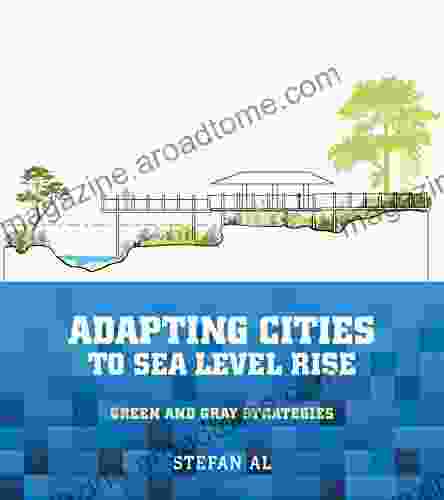Prepare for the Inevitable: Adapting Cities to Sea Level Rise

Navigating the Challenges and Opportunities of a Rising Sea

In the face of escalating global temperatures and melting ice caps, the threat of sea level rise looms large for coastal cities worldwide. As the oceans swell, cities must adapt to this impending reality to ensure the safety and prosperity of their inhabitants.
Understanding the Urgency: Impacts on Coastal Communities
Sea level rise poses multifaceted threats to coastal communities. Rising water levels lead to flooding, eroding infrastructure, salinizing freshwater sources, and disrupting ecosystems. These impacts can severely compromise human health, livelihoods, and the overall sustainability of coastal cities.
4.4 out of 5
| Language | : | English |
| File size | : | 12443 KB |
| Text-to-Speech | : | Enabled |
| Screen Reader | : | Supported |
| Enhanced typesetting | : | Enabled |
| Print length | : | 162 pages |
Flooding, a major consequence of sea level rise, poses significant risks to life, property, and infrastructure. Coastal flooding can damage buildings, roads, and power lines, disrupting daily life and emergency response. Moreover, rising water levels can exacerbate storm surges during hurricanes and other severe weather events, amplifying their destructive potential.
Infrastructure in coastal cities is particularly vulnerable to the corrosive effects of salt water. As sea levels rise, saltwater intrusion can damage bridges, roads, and other essential infrastructure, compromising their functionality and safety. Additionally, rising water levels can disrupt sewage and drainage systems, increasing the risk of waterborne illnesses and environmental degradation.
Salinization of freshwater sources is another concern associated with sea level rise. As saltwater seeps into aquifers and coastal rivers, it contaminates drinking water, rendering it unfit for human consumption or agricultural use. This can have severe consequences for water availability and food security, particularly in arid and semi-arid regions.
Embracing Adaptation: Strategies for Resilient Coastal Cities
Recognizing the urgency of these challenges, cities and governments worldwide are exploring adaptation strategies to mitigate the impacts of sea level rise. Adapting to sea level rise requires a comprehensive approach that encompasses both infrastructure upgrades and sustainable planning practices.
One of the most critical adaptation measures is elevating infrastructure. This can involve raising or reinforcing seawalls, levees, and other flood control structures to protect coastal areas from rising water levels. Elevated buildings, bridges, and roads can also provide protection against flooding and saltwater intrusion.
Another adaptation strategy is to implement green infrastructure solutions. Natural ecosystems, such as wetlands, mangroves, and oyster reefs, can act as buffers against coastal flooding and erosion. Restoring and protecting these natural barriers can enhance the resilience of coastal cities to sea level rise.
Land-use planning plays a crucial role in adaptation efforts. Restricting development in high-risk coastal areas can prevent future damage and loss of life. Similarly, encouraging development in higher elevations can reduce the vulnerability of communities to sea level rise.
Adaptive building design is also essential in coastal cities. Constructing buildings with elevated living spaces, flood-proof materials, and resilient infrastructure can mitigate the impacts of flooding and saltwater intrusion. By incorporating these design principles, buildings can remain habitable even during severe weather events.
: Embracing a Sustainable Future
Adapting cities to sea level rise is crucial for ensuring the safety, prosperity, and long-term sustainability of coastal communities. By implementing comprehensive adaptation strategies, we can mitigate the risks posed by rising water levels, protect our coastal infrastructure, and secure a thriving future for generations to come.
The imperative to adapt to sea level rise is undeniable. By embracing innovative solutions and sustainable planning practices, we can create resilient coastal cities that withstand the challenges of a changing climate. The future of our coastal communities depends on our ability to adapt, and we must act now to ensure a sustainable future for all.
4.4 out of 5
| Language | : | English |
| File size | : | 12443 KB |
| Text-to-Speech | : | Enabled |
| Screen Reader | : | Supported |
| Enhanced typesetting | : | Enabled |
| Print length | : | 162 pages |
Do you want to contribute by writing guest posts on this blog?
Please contact us and send us a resume of previous articles that you have written.
 Book
Book Novel
Novel Page
Page Chapter
Chapter Text
Text Story
Story Genre
Genre Reader
Reader Library
Library Paperback
Paperback E-book
E-book Magazine
Magazine Newspaper
Newspaper Paragraph
Paragraph Sentence
Sentence Bookmark
Bookmark Shelf
Shelf Glossary
Glossary Bibliography
Bibliography Foreword
Foreword Preface
Preface Synopsis
Synopsis Annotation
Annotation Footnote
Footnote Manuscript
Manuscript Scroll
Scroll Codex
Codex Tome
Tome Bestseller
Bestseller Classics
Classics Library card
Library card Narrative
Narrative Biography
Biography Autobiography
Autobiography Memoir
Memoir Reference
Reference Encyclopedia
Encyclopedia Peter L Steinke
Peter L Steinke Kathryn Alevizos
Kathryn Alevizos Kati Morton
Kati Morton Kendall Ann Combs
Kendall Ann Combs Kasia Wezowski
Kasia Wezowski Luna B Leopold
Luna B Leopold Riley J Ford
Riley J Ford Karen Leigh Davis
Karen Leigh Davis Kamal Arora
Kamal Arora Richard Ayoade
Richard Ayoade Kees Goossens
Kees Goossens Prem Nambiar
Prem Nambiar Kent H Redford
Kent H Redford Kenneth D Evans
Kenneth D Evans Naomi Levy
Naomi Levy Jack Oliver
Jack Oliver Nidhi Singh
Nidhi Singh Kamal Kant Hiran
Kamal Kant Hiran Karen Mitchell
Karen Mitchell Mark Gaynor
Mark Gaynor
Light bulbAdvertise smarter! Our strategic ad space ensures maximum exposure. Reserve your spot today!

 Patrick RothfussEmpower Yourself with Well Control Expertise: A Comprehensive Guide to...
Patrick RothfussEmpower Yourself with Well Control Expertise: A Comprehensive Guide to... Jonathan FranzenFollow ·10k
Jonathan FranzenFollow ·10k Jake PowellFollow ·13.3k
Jake PowellFollow ·13.3k Ralph TurnerFollow ·16.4k
Ralph TurnerFollow ·16.4k Alfred RossFollow ·8.5k
Alfred RossFollow ·8.5k Stephen FosterFollow ·13k
Stephen FosterFollow ·13k Gavin MitchellFollow ·3.2k
Gavin MitchellFollow ·3.2k DeShawn PowellFollow ·11.7k
DeShawn PowellFollow ·11.7k Chris ColemanFollow ·9.7k
Chris ColemanFollow ·9.7k

 Francis Turner
Francis TurnerLearn to Make the Perfect Tapas Dishes Through the...
If you're looking to...

 Victor Turner
Victor TurnerUnlock the Secrets of Publishing Law: A Comprehensive...
Embark on a literary journey where the...

 Casey Bell
Casey BellHealing Crystals: Essential Crystals for Beginners
Unveiling the Mystical...

 Nick Turner
Nick TurnerOne Hundred Years of Fire Insurance: A History of...
Chapter 1: The...
4.4 out of 5
| Language | : | English |
| File size | : | 12443 KB |
| Text-to-Speech | : | Enabled |
| Screen Reader | : | Supported |
| Enhanced typesetting | : | Enabled |
| Print length | : | 162 pages |













